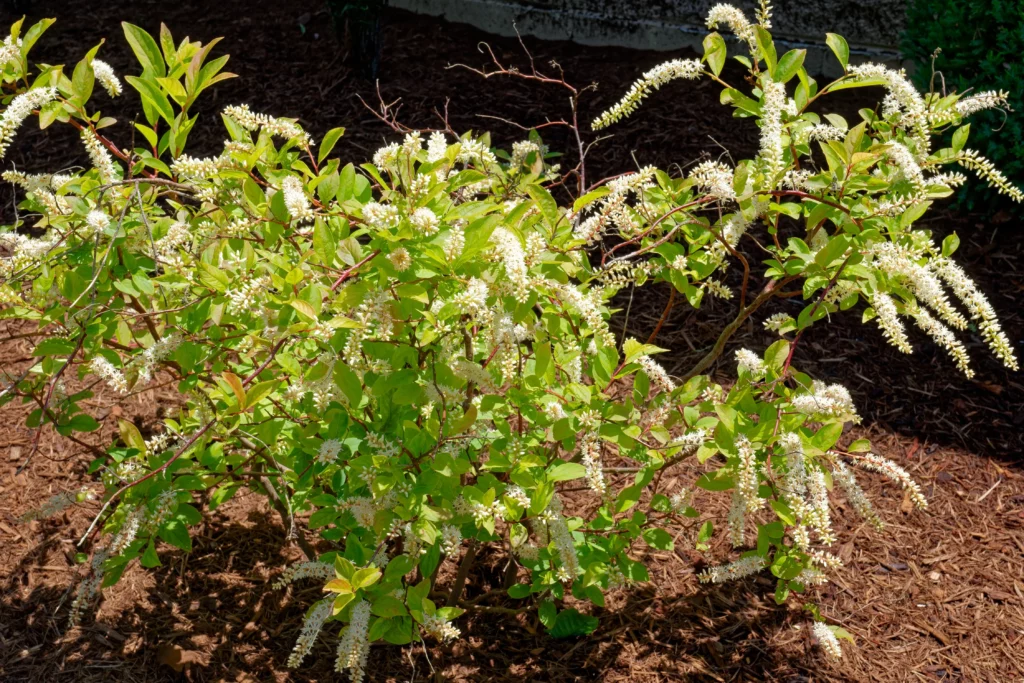Family: Sweetspire
Type: Shrub

Little Henry Sweetspire, scientifically known as Itea virginica ‘Sprich’, is a compact, versatile shrub noted for its showy white flower spikes and vibrant fall color. It’s a dwarf variety of the native sweetspire, fitting well in smaller gardens.
This plant blooms profusely in early summer with fragrant, white flowers that attract butterflies and bees. In the fall, its leaves turn a brilliant red or purple, providing exceptional autumnal interest.
Thriving in full sun to partial shade, Little Henry Sweetspire is hardy in zones 5-9. It adapts to various soil types, including wet and clay soils, making it a resilient choice for different garden conditions.
Hardiness Zone: 6a-5a
Pet Friendly: Yes
Moisture Preference: Dry to wet
Sun Needs: Full sun to shade
Growth Rate: Medium
Average Height (feet): 3
Average Spread (feet): 5
Average Life Span (years): 40
Form: Spreading
Flower Color: White
Bloom Season: In early summer
Foliage Color: Green
Leaf Fall Color: Red
Foliage Shape: Narrow
Bark Color: Brown
Bark Texture: Smooth
Incorporating Little Henry Sweetspire into your landscape adds a multi-seasonal appeal. Its compact size, fragrant flowers, and stunning fall color make it an excellent choice for a variety of garden settings.
This shrub is ideal for mixed borders, foundation plantings, and naturalized areas. Its tolerance for wet conditions makes it suitable for rain gardens or areas with poor drainage.
Despite its ornamental features, Little Henry Sweetspire is low maintenance. It’s a fantastic choice for gardeners who want a plant that offers visual interest throughout the year with minimal care.

In a cottage garden, Little Henry Sweetspire adds a charming and informal touch. Its fragrant flowers and fall color complement the relaxed style of these gardens.
For rain gardens, this shrub is a natural fit. Its ability to thrive in wet conditions makes it a functional and beautiful addition.
In wildlife gardens, Little Henry Sweetspire attracts pollinators with its flowers and provides habitat for birds with its dense foliage.
Plant it as a low hedge along pathways or property boundaries. Its compact growth habit and seasonal changes offer year-round interest.
Use it in mass plantings for a stunning display of flowers and fall color. Grouping several plants together creates an eye-catching landscape feature.
Combine it with other native perennials and shrubs. Its adaptability and native status make it a perfect companion for a variety of plants.
Select our pre-made garden layouts to create a landscape that’s uniquely yours. Simple, smart, and customizable!
In spring, Little Henry Sweetspire starts to grow its lush green leaves, preparing for the blooming season.
During summer, it showcases its fragrant white flowers, becoming a focal point in the garden.
In the fall, its foliage turns a brilliant red or purple, adding spectacular autumn color to the landscape.
In winter, Little Henry Sweetspire remains a structural element in the garden, even as its leaves drop. Its branching pattern provides visual interest in the dormant landscape.
Little Henry Sweetspire should be planted in an area with full sun to partial shade. It’s ideal for rain gardens, borders, or as a foundation plant, thriving in areas that receive adequate sunlight and have good soil moisture.
This plant thrives best in full sun to partial shade. While it can tolerate a range of light conditions, sufficient sunlight encourages the most abundant flowering and vibrant fall color.
Little Henry Sweetspire prefers moist, well-draining soil. It's adaptable to various soil types, including clay, and tolerates wet conditions well.
Space Little Henry Sweetspire plants about 3 to 4 feet apart. This allows each plant enough room to grow and develop its full potential.
The best time to plant is in the spring or early fall. Cooler temperatures during these periods are ideal for root establishment.
Dig a hole as deep as the root ball and twice as wide. Place the plant in the hole, backfill with soil, and water thoroughly. Ensure the plant is level with the surrounding ground.
Regular watering is essential, especially during dry periods and in the first growing season. Once established, Little Henry Sweetspire is quite tolerant of varying moisture conditions.
Fertilize in early spring with a balanced, slow-release fertilizer to encourage healthy growth and blooming.
Minimal pruning is required. Deadheading spent flowers and trimming back in late winter or early spring can maintain the plant’s shape and encourage new growth.
In spring, remove any old, dead foliage and apply a layer of mulch to retain moisture. Begin regular watering and fertilizing as new growth starts.
Continue to ensure the soil remains moist, especially during hot, dry spells. This is particularly important for newly planted shrubs.
Prepare the plant for dormancy by reducing watering. The fall color display requires little maintenance.
Little Henry Sweetspire is hardy in winter. Mulch the area to protect the roots in colder climates.
Little Henry Sweetspire typically grows to about 2-3 feet in height and width, forming a compact, rounded shrub.
While no plant is completely deer-proof, Little Henry Sweetspire is relatively deer-resistant and less likely to be damaged compared to other shrubs.
Little Henry Sweetspire is known for being low maintenance. Regular watering and occasional pruning are generally all that’s needed to keep it looking its best.
Sign up below to get exclusive deals, discounts, and new plant collections—delivered straight to your inbox! Plus, stay inspired with the latest gardening tips, landscaping trends, and DIY garden ideas. Start growing with us today!
A big thank you for subscribing to the PBN Design newsletter.
We're thrilled to have you join our community. Get ready for exciting updates, insightful content, and more delivered straight to your inbox.
Stay tuned!
Go backA big thank you for subscribing to the PBN Design newsletter.
We're thrilled to have you join our community. Get ready for exciting updates, insightful content, and more delivered straight to your inbox.
Stay tuned!
Go back